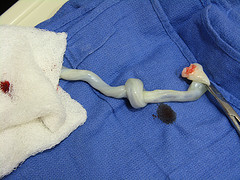I read many books during both of my pregnancies on natural birth, in particular water birth. The first question many people ask about water birth is what if the infant takes its first breath under water. The answer lies in the umbilical cord and lungs work together during those first minutes of life to transition the baby to living outside of the womb.
One thing I learned that was never discussed with my parallel care doctor but brought up by my midwives was the benefit of delayed cord clamping. Waiting until the umbilical cord stops pulsing to clamp and sever simply makes sense. Let it finish its job. Now, researchers have found more benefits to delayed cord clamping beyond motherly intuition.
Medscape reports:
Allowing placental blood to flow into the neonate for 3 minutes, rather than cutting the umbilical cord within the first 10 seconds, as is common, increases blood volume sufficiently to elevate ferritin at 4 months, finds a study published online November 16 in the British Medical Journal…
Ola Andersson, MD, a neonatologist at the Hospital of Halland in Sweden, and colleagues enrolled 400 full-term infants born after low-risk pregnancies between April 2008 and September 2009, and randomized the time of cord cutting to either 10 seconds or 3 minutes. When a birth was imminent, the midwife would open an envelope assigning either cord-cut time. Midwives held the neonates 20 cm below the level of the mothers’ vulvas for 30 seconds and then placed the infants on the mothers’ abdomens to facilitate blood transfer….
Every 20 babies having delayed clamping could prevent 1 case of iron deficiency, the researchers estimate. They conclude that delayed clamping “should be considered as standard care for full term deliveries after uncomplicated pregnancies.”
Patrick van Rheenen, MD, a consultant pediatrician at the University of Groningen in the Netherlands, agrees in an accompanying editorial that “enough evidence exists to encourage a routine change in practice.”
Finally, the medical community is recommending a change to the barbaric practice of cord clamping immediately after a child is born. In my experience, we waited at least 15 minutes before severing my children’s umbilical cords. What’s the rush?
Check out our contribution on gratitude on the Natural Parents Network!
Image credit: Some rights reserved by rsgranne

This is great news! My birth plan was to wait until the cord stopped pulsing before my doctor would cut. He agreed to abide by my request, even though he said it had “no benefits”. Well, he was out of town the weekend I delivered, and I had a very precipitous birth. I met the on call doctor right before my son was crowning. As soon as he came out, I yelled, “don’t cut the cord!” He looked at me and said, “we don’t wait here” and clamped. It broke my heart. I hope more doctors learn of the benefits of delayed clamping, or at least respect moms wishes in wanting to wait.